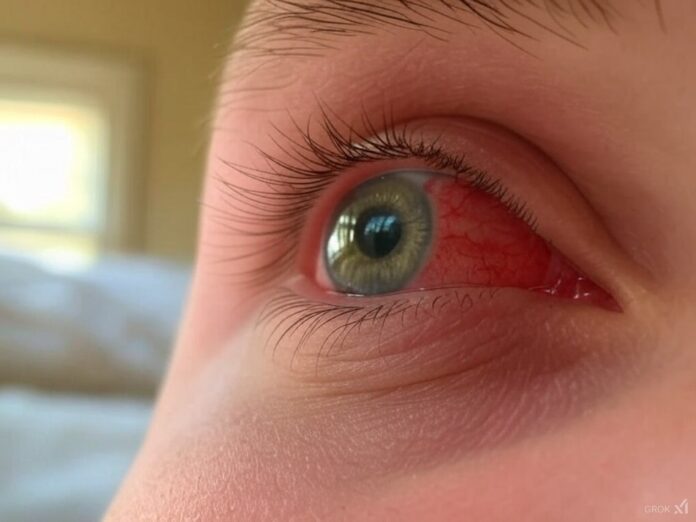Conjunctivitis, commonly known as “pink eye,” is a condition that many of us may experience at some point. It causes redness, irritation, and discomfort in the eyes, often leading to questions about whether it’s safe or responsible to go to work. This article will help you understand the different types of conjunctivitis, when it’s appropriate to work, and how to manage it responsibly.
1. What is Conjunctivitis?
Conjunctivitis refers to inflammation of the conjunctiva, the thin membrane covering the white part of the eye and inner eyelids. It’s caused by various factors, including infections and allergies. Understanding the type of conjunctivitis you have is crucial in determining whether you can attend work without risking others’ health.
Types of Conjunctivitis:
- Viral Conjunctivitis
- Highly contagious and often caused by adenoviruses.
- Symptoms: Redness, watery discharge, and irritation.
- Transmission: Spreads through direct contact, contaminated surfaces, or respiratory droplets.
- Bacterial Conjunctivitis
- Also contagious but less so than viral conjunctivitis.
- Symptoms: Thick, yellow or green discharge and crusting around the eyes.
- Transmission: Spreads through touch, shared objects, or hand-to-eye contact.
- Allergic Conjunctivitis
- Non-contagious and triggered by allergens like pollen, dust, or pet dander.
- Symptoms: Itchy, watery eyes and swelling.
- No risk of spreading to others.
2. Should You Go to Work with Conjunctivitis?
The decision to go to work depends on the type of conjunctivitis and the severity of your symptoms. Here’s a breakdown:
Viral Conjunctivitis
- Recommendation: Avoid work during the contagious period (often 3-7 days).
- Reason: Highly infectious and easily spread through shared surfaces and close contact.
- When Safe to Return: When symptoms improve and your doctor confirms it’s no longer contagious.
Bacterial Conjunctivitis
- Recommendation: Ideally, stay home until 24-48 hours after starting antibiotic treatment.
- Reason: Contagious but manageable with proper precautions, such as frequent handwashing and avoiding shared items.
- When Safe to Return: After antibiotic treatment begins and symptoms significantly reduce.
Allergic Conjunctivitis
- Recommendation: Safe to attend work.
- Reason: Non-contagious and manageable with antihistamines or eye drops.
- Precautions: Use personal tissues and avoid rubbing your eyes to reduce irritation.
3. Workplace Considerations
Employer Responsibilities
- Encourage employees with contagious illnesses to stay home.
- Offer remote work options or sick leave policies to reduce workplace transmission.
- Promote hygiene practices such as hand sanitizers and regular cleaning.
Employee Responsibilities
- Communicate openly with your employer about your condition.
- Avoid close contact with colleagues if there’s a risk of spreading conjunctivitis.
- Follow workplace policies on illness and medical leave.
4. Reducing the Risk of Transmission at Work
If you must go to work or are returning after treatment, follow these guidelines to minimize the risk:
- Practice Good Hygiene:
- Wash your hands frequently with soap and water for at least 20 seconds.
- Avoid touching your eyes, face, or shared surfaces.
- Use Protective Measures:
- Carry personal hygiene items like tissues, hand sanitizer, and disinfectant wipes.
- Wear glasses instead of contact lenses to avoid further irritation and limit exposure.
- Disinfect Shared Items:
- Clean keyboards, phones, door handles, and other frequently touched objects.
- Stay in Your Workspace:
- Limit movement around the office and avoid close interactions with others.
5. Seeking Professional Advice
It’s always wise to consult a healthcare professional if you suspect conjunctivitis. They can:
- Confirm the type of conjunctivitis.
- Provide appropriate treatment, such as antibiotics or antihistamines.
- Issue a medical certificate for your employer if required.
When to See a Doctor:
- Symptoms persist or worsen after a few days.
- You experience significant pain, vision changes, or extreme swelling.
- Unsure if your conjunctivitis is contagious or safe for work.
6. Practical Tips for Managing Conjunctivitis
- At Home:
- Avoid sharing towels, pillows, or makeup.
- Clean your hands before and after applying eye drops or ointments.
- At Work:
- Keep a distance from colleagues, especially in shared spaces.
- Use disposable tissues and discard them immediately after use.
- Avoid attending meetings or group activities if possible.
7. Conclusion
The decision to go to work with conjunctivitis depends on its type, severity, and your workplace’s policies. While allergic conjunctivitis is generally safe, viral and bacterial conjunctivitis require caution to prevent spreading the infection. Always prioritize hygiene, consult a healthcare professional when necessary, and communicate with your employer to ensure a responsible approach.
By taking these steps, you protect not only your health but also that of your colleagues, fostering a safer and more considerate work environment.
Resources for Further Reading
- Centers for Disease Control and Prevention (CDC)
- World Health Organization (WHO)
- Local workplace health and safety guidelines.
Also See: Can You Eat Halloumi When Pregnant











Helpful guide! It’s important to be cautious with conjunctivitis, especially around others. Taking the right precautions can help prevent spreading it while still managing work commitments